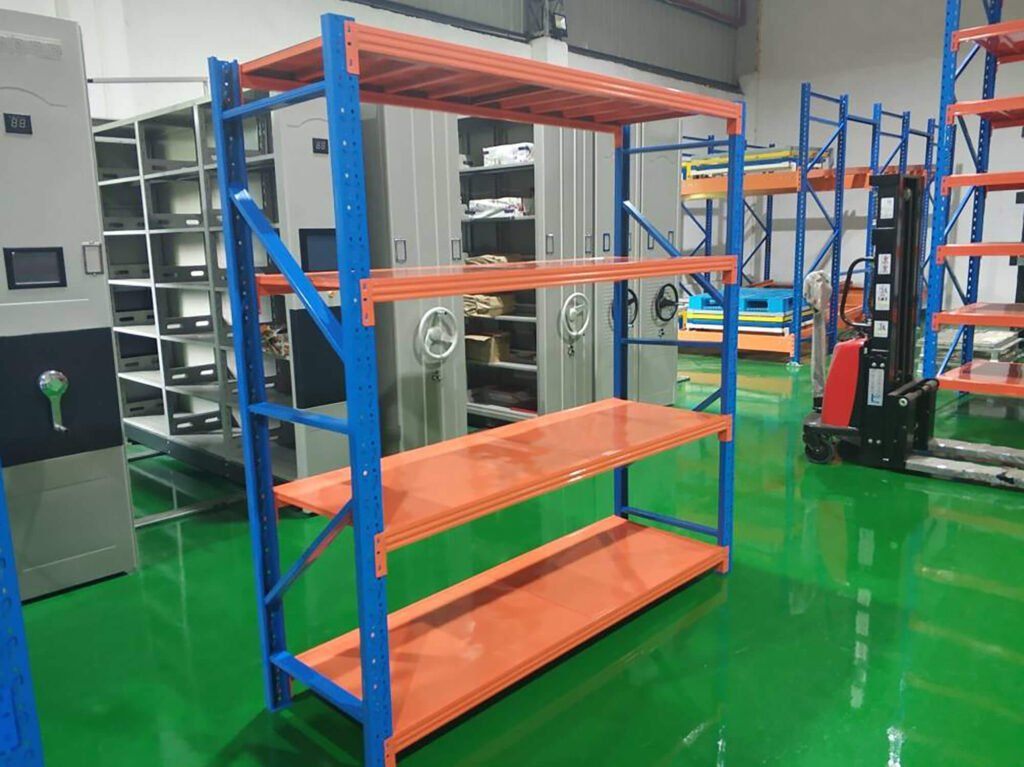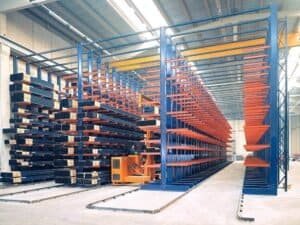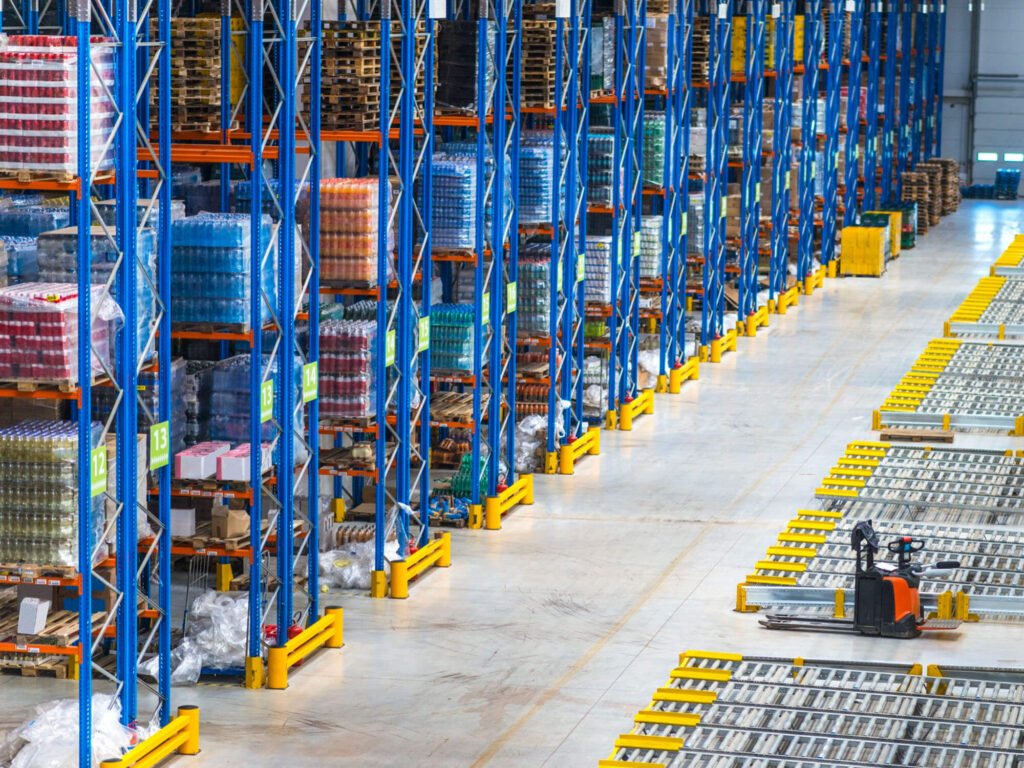The wrong choice of racking system can lead to spending too much time or money, or facing unsafe storage problems. Thus, a thoughtful decision between heavy-duty and light duty racking systems comes down to efficiency, durability, and return on investment.
You don’t have to worry about it; in this blog, you will learn about heavy-duty racking vs light-duty racking in a detailed way. And, you will be able to select the right one. So stay connected!
1) What is Heavy Duty Racking?
“Heavy duty racking is a storage system capable of withstanding large, heavy or palletised loads.”
Generally, this equipment can be found in warehouses, factories, and large-scale storage facilities. Moreover, heavy racking systems also improve safety and access to products during their storage.
Furthermore, this rack is designed to be strong and durable. Thus, this system is best for warehouses and companies that bear a heavy load, as it protects from bending or damage. Therefore, businesses prefer heavy-duty racking to increase productivity, safety, and storage space.
- Materials Used
Typically, heavy-duty racks are constructed of high-end steel or reinforced frames. These items can withstand weight, endure abrasion, and have long-lasting durability. In addition, the steel that is coated also becomes rust-resistant, making it suitable for heavy-duty uses and outdoor applications.
- Load-Bearing Capacity
Well, heavy racking has many benefits, one of which is its load-bearing capacity. Depending on the design, each level of the rack can hold hundreds to thousands of kilograms. Therefore, storing large items, parts of machines, or bulk goods is hassle-free and risk-free.
- Common Types
Commonly, heavy-duty systems have various types. Let’s discuss two common types:
i) Pallet racking: It continues to dominate the market due to its ease of access with Pallet trucks.
ii) Cantilever racking: It is more specialised and designed for longer and bulkier items, such as pipes and timber.
Well, every type has some advantages to suit your storage requirements.
- Suitable Industries and Storage Needs
Alright! You know heavy racking is found in industrial warehouses, manufacturing plants, and cold storage facilities. However, their use extends to distribution and logistics centres as well.
Thus, whether the business is storing raw materials, packaged goods, or even heavy machinery, industrial pallet rack systems help speed up workflows while keeping everything organised.
2) What is Light Duty Racking?
“Light-duty racking is a storage system capable of withstanding smaller and lighter item loads.”
Generally, these are found in the retail backrooms, in office spaces, or in small workshops. Most importantly, this type of storage solution keeps items neat, well-organised, and easily accessible while also protecting them from damage.
Moreover, this type of racking is less relevant when heavy loads must be stored. Thus, this approach is economical when organising items ranging from products to tools and even documents. Another plus point is that, with the light-duty racking, you can make the most of your available space without overspending.
- Materials Used
Typically, Light racks are manufactured from steel and aluminium. Their everyday strength makes them easy to handle and move. Moreover, their lighter weight makes the assembly of the storage more streamlined and faster.
- Load-Bearing Capacity
You know, in contrast to heavy-duty systems, light-duty racking systems are designed to hold less weight. Well, they’re best for boxes, files and even small equipment. Moreover, moderate weight is carried by most shelving, particularly those found in dynamic environments of heavy loading and unloading.
- Common Types
Let’s discuss two common types of light-duty racking.”
i) Boltless shelving: They are easy to use. Moreover, their height can be made to accommodate the user.
ii) Slotted angle racks: These are also flexible in design and can be constructed into multiple shapes.
- Appropriate Sectors and Storage Requirements
Alright! You know, Light racks can be found in homes, small businesses, and even libraries. Moreover, it is suitable for tools, retail products, and even archived files. However, most office and shop racking and storage systems are based on light-duty systems because they are economical and offer value for money.
Furthermore, light racking is ideal for organising your storage from warehouse racks for light goods to simple garage shelving units. In addition, it is effective and simple, making it a smart choice for those who desire a streamlined, efficient process.
3) Key Differences Between Heavy-Duty and Light-Duty Racking
Honestly speaking, it is very important to understand the key differences between the two rankings while choosing the suitable one for your project. Let’s discuss:
i) Load Capacity
Heavy-duty racking: It is ideal for businesses that need to store bulky and heavy goods because it can store large and heavy goods. You know, individual racks can store thousands of kilograms and are ideal for bulk storage and industrial use.
Light-duty racking: On the other hand, it is ideal for boxes, files, and other light products that require less load strength. Moreover, it is more suitable for light and small items.
ii) Construction and Material Strength
Heavy-duty racking: Well, steel and thick materials are used in making heavy-duty racks. However, they are reinforced, which protects them from bending, warping, and corrosion, giving them a long-lasting lifespan.
Light-duty racking: In contrast, light-duty racks are made of light steel and aluminium. Unlike their modern counterparts, light-duty racks focus on easy handling and portability and smooth distribution.
iii) Design & Flexibility
Heavy-duty racking: You know pallet racking and cantilever designs are common features of heavy-duty systems. While they offer some adjustability, they are optimised for deep load stability.
Light-duty racking: Conversely, light-duty systems have features of boltless shelving or slotted angle racks. However, these are easy to adjust and quick to change to meet new requirements.
iv) Installation Complexity
Heavy-duty racking: Keep in mind, more complex designs like heavy-duty racks require more time, tools, and manpower due to their need for forklifts and professional installers. As the name suggests, heavy-duty racks come with a series of challenges.
Light-duty racking: On the other hand, light-duty racks offer effortless and boltless installation that can be done single-handedly by one or two people.
v) Maintenance Needs
Heavy-duty racking: Lastly, just like every other heavy-duty product, heavy-duty racking comes with a shelf life. While they can contain large weights, inspections and minor adjustments have to be made to maintain their rigidity.
Light-duty racking: In contrast, using light-duty racking brings a different approach. While their shelf life increases, their light structure comes at the price of requiring maintenance instantly.
| Feature | Heavy-Duty Racking | Light Duty Racking |
| Load Capacity | High – up to thousands of kg per level | Low – suitable for small, lightweight goods |
| Material Strength | Thick steel, reinforced frames | Lighter steel or aluminium |
| Design & Flexibility | Stable, with less reconfiguration | Highly adjustable and modular |
| Installation | Time-consuming; may need professional help | Quick, simple, DIY-friendly |
| Maintenance | Occasional inspections, very durable | Low maintenance, shorter lifespan if overloaded |
4) Price Comparison
You know light and heavy-duty racks display a significant price difference, which determines load-bearing capability and strength, and they offer value for money based on strength, size and overall design.
- Heavy-Duty Racking Price Range
Well, Heavy racking is built for durability and elevation in load capacity. However, basic pallet rack systems usually start around $200–$400 per bay. Moreover, more complex designs, such as cantilever racking or drive-in racks, may exceed $500–$1,000 per bay, depending on height and material used.
- Light Duty Racking Price Range
Light-duty racking is more cost-effective. Its simple boltless shelving units can be purchased for $50–$150. But more complex systems, for example, garage storage or modular office racks, may range from $150 to $300 based on their size and other features.
- Cost-Impacting Factors
- Material Quality: Coated steel is more expensive when compared to lighter untreated metals.
- Customisation and Size: Another factor is that extra accessories for taller racks come with additional costs.
- Load Capacity: Each shelf with heavier loads requires stronger framing, thus increasing costs.
- Cost efficiency for the long term: Lastly, heavy-duty racks are often more economical over the long term compared to light-duty racks, which may require more frequent replacement.
- Choosing the Best Value
Alright! Heavy-duty systems will save you money on replacements and maintenance if you primarily store large and heavy goods. Moreover, Light-duty options are best for storing lightweight goods, giving you the best storage at an economical price.
In simple words, a combination of budget, load requirements, and long-term strategies will drive the decision. Thus, evaluation based on highlighted features along with pricing will help in obtaining a storage solution that best balances performance and cost over the long term.
5) Applicable Scenarios for Each Type
Most importantly, Heavy-duty and light-duty racking options become simpler to select when tailored to match the specific storage requirements. Let’s discuss:
Heavy-Duty Racking is Best For
a) Industrial warehouses: Most importantly, manufacturing and industrial warehouses use heavy-duty systems for raw and bulk product storage as well as large pallets. Moreover, the systems do well to endure constant lift truck traffic and vertical stacking.
b) Automotive parts storage: Next, Automotive parts storage derives benefits from heavy-duty racks that support substantial weight from parts such as heavy engines, tyres, and other tools.
c) Cold storage facilities: Next, cold storage facilities depend on industrial pallet racks that support low-temperature environments while maintaining structural integrity.
d) Bulk storage and high-volume goods: Lastly, businesses and warehouses dealing with bulk storage and high-volume goods require the capacity and stability offered by heavy-duty racks to ensure everything is store-organised.
Light Duty Racking Best For
a) Retail backrooms: Light-duty racks are used in the back rooms of retail outlets to keep stock well organised and easy to access during the re-stocking process.
b) Small workshops: The next factor point is that small workshops are well served by adjustable shelving for tools, parts, and other materials.
c) Document storage: Next, offices’ and libraries’ document storage can store files neatly on boltless or slotted racks.
d) Home or small business inventory: Finally, small businesses and homes can store inventory on compact racks that fit in smaller spaces or on garage storage shelves.
6) Pros and Cons Summary Table
To be honest, you can quickly decide which racking storage solution is best for you by checking the advantages and disadvantages of light and heavy-duty racking systems side by side. Thus, it is very helpful for you.
Feature | Heavy-Duty Racking – Pros | Heavy-Duty Racking – Cons | Light Duty Racking – Pros | Light Duty Racking – Cons |
| Strength | Very strong and stable for heavy goods | Heavy to move and install | Lightweight and easy to handle | Not suitable for heavy loads |
| Durability | Long lifespan, resistant to wear | Higher initial cost | Affordable and budget-friendly | Shorter lifespan under heavy use |
| Capacity | Holds thousands of kg per level | Needs more space | Perfect for small, light goods | Limited load capacity |
| Flexibility | Adjustable but mainly built for fixed use | Less easy to reconfigure | Highly adjustable and modular | Can become unstable if overloaded |
| Installation | A professional setup is often required | Time-consuming | Quick and easy to install | May require more frequent adjustments |
| Maintenance | Low repair needs if well-maintained | Requires regular inspections | Minimal upkeep | More replacements over time |
7) How to Choose the Right Racking for Your Needs
Significantly, choosing the ideal storage rack systems for your warehouse highly relies on the items you store, the space available, and your budget. Thus, making the right decision can greatly enhance storage efficiency and reduce overall costs.
Assessing Load Requirements
Firstly, when determining your storage requirements, start by knowing the weight and size of the items you intend to store. However, Items such as heavy machinery parts or bulk goods, as well as pallets, require heavy duty shelves which are sturdy and can withstand heavy loads. But other items, like small boxes and documents or retail products, are best suited to light-duty racks. Thus, preventing damage helps in storage safety.
Considering Available Space
Secondly, available floor space as well as height dimensions should be taken into consideration. In the case of an area with high ceilings, vertical storage can be used to store items to the maximum.
For large spaces, industrial warehouse racks are best suited, while compact shelving is more preferable in smaller spaces, such as in workshops or garages.
Budget Planning
The next factor is that you should be ready to prepare a budget that goes beyond just the racks and includes installation and upkeep. Although heavy-duty racking is more expensive initially, it has a longer lifespan.
On the other hand, light-duty systems tend to be more affordable, but the increased need to pay for replacing them in the near term, off the back of frequent use, makes them a worse long-term investment. Thus, you should consider the balance of the price with its long-term value.
Future Scalability
Lastly, you should be sure to think about the storage solutions in place if your needs change in the future.
Thus, designs that are modular make it easy, as you can add sections without necessitating a complete system replacement.
8) Conclusion
Alright! Heavy-duty racking is designed for high load-bearing capacity and long-term durability, while light-duty racking is designed for smaller or lighter items, high flexibility, and ease of setup. The right option depends on load requirements, available space, and budget.
Thus, safety, efficiency, and cost savings are achieved when racking is matched to the business requirements. If you have a small business, retail storage, or home organisation, we recommend the Light Duty Rack, Mezzanine racking, cantilever racking, and others from Lracking. It is inexpensive, effortless to assemble, and provides storage that is easy to access and organise. You can contact us right now!




